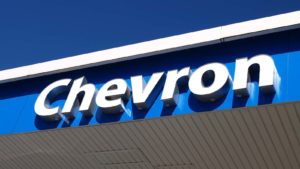[Editor’s note: “After 70% Rebound, It’s Time to Ditch Chevron Stock” was originally published April 6. It has since been updated to reflect the most relevant information available.]

What’s next for Chevron (NYSE:CVX)? Like its major oil company peers, Chevron stock has been hammered thanks to record low energy prices, and, of course, weakened demand due to the novel coronavirus.
But, as shares have rebounded about 70% from their 52-week low ($51.60 per share), is the stock a buy at today’s prices?
It all depends. If the current headwinds subside sooner than predicted, shares could head continue heading back to past highs (around $120 per share). On the other hand, if weakened demand means oil stays far below $50 per barrel, expect shares to drip from their current price level (between $85-$90 per share).
With this in mind, it doesn’t look promising to buy CVX at today’s prices. Why buy now, if you could wait for shares to fall back to below $60 per share?
As the macro outlook remains terrible for the energy sector, it may be time to sell. A bird in one hand is worth two in the bush. If you bought when shares were near their lows, take the money and run!
Low Energy Prices and Chevron Stock
The Saudi-Russian oil price war lit the spark. But it’s the pandemic helping to keep oil prices low. As InvestorPlace’s Josh Enomoto wrote April 22, it’s demand, not supply, that’s bad news for Chevron.
Many factors at play will hurt demand going forward. With social distancing, car usage has plummeted. But that doesn’t mean energy prices will necessary pick up once Americans working from home head back to the office.
A weakened economy could linger on long after the outbreak ends. Considering it’s debatable whether we’ll see a V-shaped (sudden), or a U-shaped (slower) recovery, don’t expect things to bounce back to 100% within a few months.
What does that mean for oil? Expect low prices to continue. As it stands now, oil trades before $20 per barrel. But that’s even below the breakeven price of Chevron’s more profitable operations. In short, expect the company to continue playing defense until energy prices bounce back.
Dividend and Valuation
A key question regarding Chevron is the dividend. Even after rallying in recent weeks , the company still has a “high yield” dividend. As today’s prices, the yield stands at 5.8%.
Yet, that high yield also demonstrates investors remain fearful of a dividend cut. However, this doesn’t appear to be in the cards. The company recently announced it plans to cut production and expenses in order to conserve cash.
Chevron’s management knows the importance of maintaining its dividend. It knows many of its shareholders are income investors. If they cut the dividend, these investors will bail, sending shares lower.
Assuming the dividend is safe, shares could see limited downside. Yet, is there a pathway for shares to move higher in the next year?
That’s going to be a challenge. For the stock to rebound back above $100 per share, we need to see oil make a big comeback.
Back in 2018, Chevron posted earnings of $14.9 billion. But that’s back when the average closing price of oil was around $65 a barrel. Oil prices may have to return to such levels in order to move the needle again.
Given today’s oil price trends, prices would have to jump more than three-fold for that to happen!
Sell CVX Now, But Consider Reentry at Lower Prices
With low energy prices due to the coronavirus, don’t expect Chevron to reach its past high-water mark anytime soon. And after the epic rally seen in recent weeks, it’s reasonable to assume shares will pull back.
Yet, that’s not to say the stock will retest past lows. The company’s recent moves to protect the dividend is a positive factor. In a low-interest world, it’s tough to find yield. Income investors may help support the stock’s current price level.
Regarding upside, nothing’s guaranteed. We could see a long-term oil price slump. But given the unpredictability of oil markets, crude oil prices could rebound back to prior levels, moving the needle. However, this is a long-shot catalyst for now.
Bottom line: consider a Chevron a sell. Shares may be a buy at lower prices. But if you bought in the last month, take the money and run.
Thomas Niel, contributor to InvestorPlace, has written single-stock analysis for web-based publications since 2016. As of this writing, Thomas Niel did not hold a position in any of the aforementioned securities.
